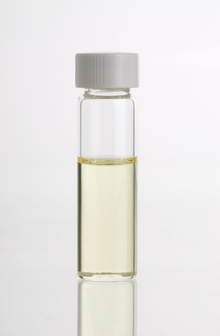Lavender oil

Lavender oil is an
Production
Pure lavender essential oil is produced through steam distillation.[1][2] This generates a greater amount of oil compared to other methods due to reduction of polar compound loss.[3] Harvest of lavender blooms is typically between late June and August.[4] The cut lavender flowers and stems are compacted into a lavender still. A boiler is then used to steam the bottom of the lavender flower filled still at a very low pressure.[1] The lavender flower pockets containing oil are broken from this heating process and a pipe of cold water is run through the center of the still.[1] The hot lavender oil vapor condenses on the cold pipe with the cold water and is collected into a holding tank where it is allowed to settle.[1] Due to polarity and densities of the water and oil, these two will separate in the holding tank whereupon the water is piped out, leaving just lavender essential oil.[5]
Lavender oil is produced around the world, with Bulgaria, France and China leading its production.[6][7]
Uses
Lavender oil has been used as a
A 2021 meta-analysis included five studies of people with anxiety disorders. All five studies were funded by the manufacturers of the lavender oil capsule used, four of them were conducted by one author of the meta-analysis,[11] and blinding was not clear.[12] In this analysis, an oral 80 mg dose of lavender oil per day was associated with reduced anxiety scores on the Hamilton Anxiety Rating Scale.[11] According to the National Center for Complementary and Integrative Health, the effectiveness of using oral lavender oil for treating anxiety remains undetermined due to the limitations of these studies.[9]
Oil of spike lavender was used as a solvent in oil painting, mainly before the use of distilled turpentine became common.[13]
Possible adverse effects
Although lavender oil is generally recognized as safe for its intended uses,[14] it is a potential endocrine disruptor that may affect breast development in children.[15]
Many essential oils, including lavender oil, can be poisonous if swallowed.[16][17] In general, 5 millilitres (0.17 US fl oz) of a diluted essential oil may cause toxicity in adults, whereas 2–3 millilitres (0.068–0.101 US fl oz) can be toxic in children.[18] Over 2014-18 in New South Wales, there were 271 reported cases of lavender oil poisoning – mostly in children – accounting for 6.1% of all essential oil poisoning cases.[17] The main toxic constituents of lavender oil are linalyl acetate and linalool.[16][19]
Symptoms of lavender oil poisoning by ingestion include blurred vision, difficulty breathing, burning pain in the throat, burns to the eye, confusion, decreased level of consciousness, diarrhea, stomach pain, vomiting, and rash.[16] Topical application of lavender oil may cause contact dermatitis.[18]
Ingestion of lavender oil may cause interactions with prescription drugs, including anticoagulants, statins, and anticonvulsants.[20]
Phytochemicals
The
The composition of lavender essential oil as obtained by chromatography:[22]
| Family | Composition | Lavande officinale Lavandula angustifolia |
Lavande aspic Lavandula latifolia |
|---|---|---|---|
| Terpenes / Monoterpenols |
Linalool |
28.92 % | 49.47 % |
α-Terpineol |
0.90% | 1.08% | |
γ-Terpineol |
0.09% | ||
| Borneol | 1.43% | ||
| Isoborneol | 0.82% | ||
| Terpinen-4-ol | 4.32% | ||
| Nerol | 0.20% | ||
| Lavandulol | 0.78% | ||
| Terpenes / Terpene esters |
 Linalyl acetate Linalyl acetate |
32.98 % | |
| Geranyl acetate | 0.60% | ||
| Neryl acetate | 0.32% | ||
Octene-3-yl acetate |
0.65% | ||
| Lavandulyl acetate | 4.52% | ||
| Terpenes / Monoterpenes |
Myrcene | 0.46% | 0.41% |
α-Pinene |
0.54% | ||
β-Pinene |
0.33% | ||
| Camphene | 0.30% | ||
| (E)-β-Ocimene | 3.09% | ||
| (Z)-β-Ocimene | 4.44% | ||
| β-Phellandrene | 0.12% | ||
| Terpenes / Terpenoid oxides |
 Eucalyptol (1,8-cineol) |
25.91 % | |
| Terpenes / Sesquiterpenes |
β-Caryophyllene | 4.62% | 2.10% |
| β-Farnesene | 2.73% | ||
| Germacrene | 0.27% | ||
| α-Humulene | 0.28% | ||
| Ketones |  Camphor |
0.85% | 13.00 % |
| 3-Octanone | 0.72% | ||
 Cryptone |
0.35% |
References
- ^ ISBN 978-0-203-21652-1.
- ^ Health (U.S.), National Institute of (1919). Digest of Comments on The Pharmacopœia of the United States of America and on the National Formulary for the Calendar Year ... 1905-1922. U.S. Government Printing Office.
- ISSN 0959-6526.
- ISBN 978-0-87857-792-7.
- PMID 16290453.
- ^ Mihala, Lorelei (2020-07-30). "Bulgarian lavender: The sweet smell of success". BBC News. Retrieved 2020-08-03.
- S2CID 107300743.
- ISBN 978-0-7514-0403-6.
- ^ a b c "Lavender". National Center for Complementary and Integrative Health, US National Institutes of Health. 1 August 2020. Retrieved 1 July 2022.
- PMID 32813272.
- ^ PMID 33638614.
- S2CID 42697028.
- ISBN 978-0-19-531391-8.
- ^ "Sec. 182.20 Essential oils, oleoresins (solvent-free), and natural extractives (including distillates)". FDA. Retrieved 24 March 2022.
- ^ "Endocrine disruptors". National Institute of Environmental Health Sciences, US National Institutes of Health. 2 June 2023. Retrieved 5 July 2023.
- ^ a b c "Lavender oil". MedlinePlus, National Library of Medicine, US National Institutes of Health. 13 November 2021. Retrieved 9 January 2020.
Poisonous ingredient: It is mainly the linalyl acetate and linalool in lavender oil that are poisonous.
- ^ S2CID 207940224.
We found that essential oil exposures are frequent in Australia, and that more than half involve children. ... severe toxicity can be caused by as little as 5 mL
- ^ a b "Essential oil poisoning". Royal Children's Hospital, Melbourne, Australia. July 2021.
Volumes of 5-15 mL are likely to cause toxicity in adults
- PMID 29230418.
- ^ a b c d "Lavender". Drugs.com. 22 October 2021. Retrieved 25 May 2022.
- PMID 12350096.
- S2CID 104553013.
